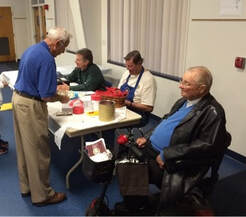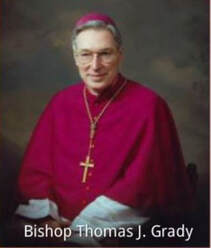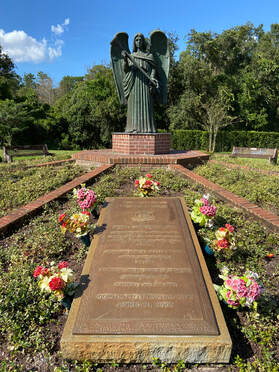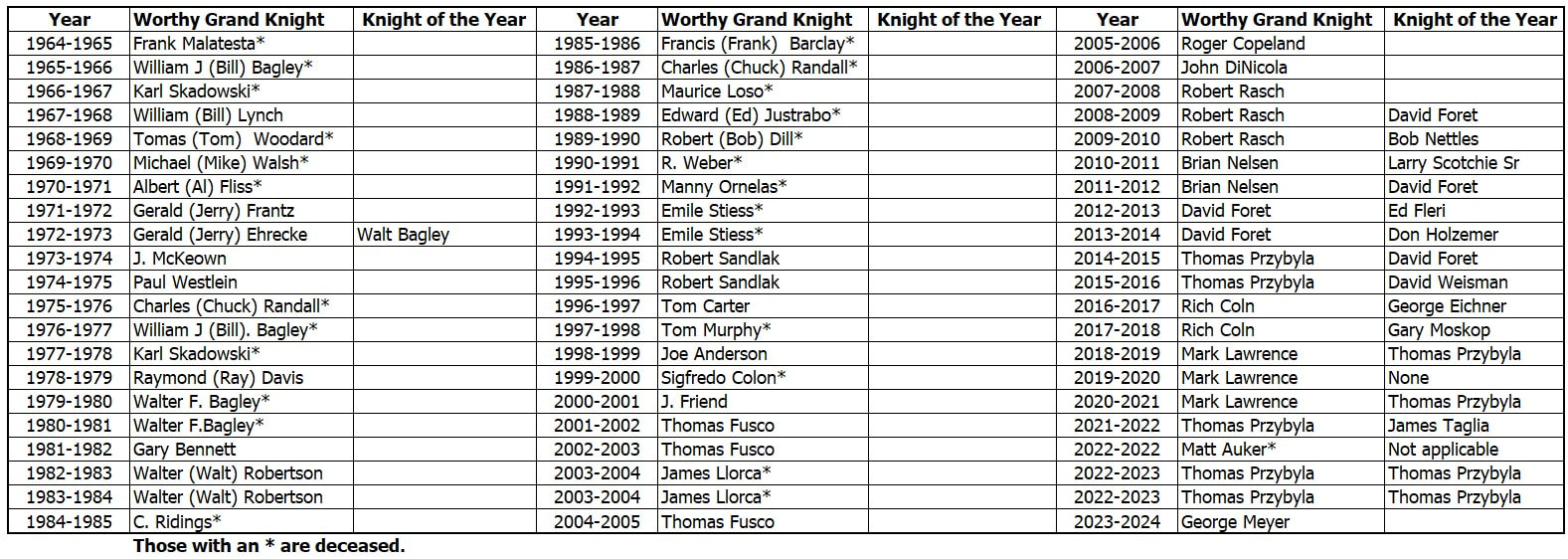Links
Knights of Columbus Supreme Council website: http://www.kofc.org
Knights of Columbus Florida State Council website: http://www.floridakofc.org/
Knights of Columbus Charities Inc. website: http://www.kofc.org/un/en/charities/index.html
Saint Mary Magdalen Catholic Church website: http://www.stmarymagdalen.org/
Knights of Columbus Florida State Council website: http://www.floridakofc.org/
Knights of Columbus Charities Inc. website: http://www.kofc.org/un/en/charities/index.html
Saint Mary Magdalen Catholic Church website: http://www.stmarymagdalen.org/
Bishop Thomas J. Grady
Story of the Knights of Columbus
|
Father Michael J. McGivney is
the founder of the Knights of Columbus, which has become the world’s largest
Catholic fraternal group, with more than 1.8 million members organized in
15,000 councils around the world. Born in Connecticut of Irish immigrant parents just a few
years before the Civil War, Michael McGivney grew up in a time when millions of
Catholic immigrants were struggling to overcome poverty and prejudice.
When his own father died suddenly, McGivney interrupted his seminary studies to help care for his mother and siblings. Throughout the immigrant community, he saw families be split apart and devastated by the untimely death of a breadwinner. These tragedies and his experience as pastor had a deep effect on him, leading him to found the Knights of Columbus to aid widows and orphans, thus protecting Catholic families, and to engage in acts of charity and strengthen the faith of its members. Father McGivney is a priest who may one day be the first American-born parish priest to be declared a saint. In 2008, the Vatican declared Father McGivney “Venerable,” the first step on the road to sainthood. His cause for beatification is under consideration at the Vatican. Knights of Columbus Thanks to the efforts of Father Michael J. McGivney, assistant pastor of St. Mary’s Church in New Haven Connecticut and some of his parishioners, the Connecticut state legislature on March 29, 1882, officially chartered the Knights of Columbus as a fraternal benefit society. The Order is still true to its founding principles of charity, unity and fraternity. The Knights was formed to render financial aid to members and their families. Mutual aid and assistance are offered to sick, disabled and needy members and their families. Social and intellectual fellowship is promoted among members and their families through educational, charitable, religious, social welfare, war relief and public relief works. The Knights of Columbus has grown from several members in one council to more than 15,000 councils and 1.8 million members throughout the United States, Canada, the Philippines, Mexico, Poland, the Dominican Republic, Puerto Rico, Panama, the Bahamas, the Virgin Islands, Cuba, Guatemala, Guam and Saipan. The Knights is a FAMILY oriented, Catholic, Service fraternity organization. Nothing is secret about the Knights, except their degree ceremonials. A man enters the Knights when he takes his 1st Degree (like a Page in the old medieval times). As he learns more about the Knights, he takes his 2nd Degree (like a Squire of Old). Finally when his council feels he is ready, he will take his 3rd Degree and become a full Knight (Like a Knight of Old). The last degree, the 4th degree is when a Knight becomes a sir Knight. |
4 Core Principles
All the good works we do are informed by our four core principles: Charity - Our Catholic faith teaches us to “Love thy neighbor as thyself.” Members of the Knights of Columbus show love for their neighbors by conducting food drives and donating the food to local soup kitchens and food pantries, by volunteering at Special Olympics, and by supporting, both spiritually and materially, mothers who choose life for their babies. Knights recognize that our mission, and our faith in God, compels us to action. There is no better way to experience love and compassion than by helping those in need, a call we answer every day. The focus of the first degree is on Charity. Unity – None of us is as good as all of us. Members of the Knights of Columbus all know that – together – we can accomplish far more than any of us could individually. So we stick together…we support one another. That doesn’t mean that we always agree or that there is never a difference of opinion. It does mean that – as a Knight of Columbus – you can count on the support and encouragement of your brother Knights as you work to make life better in your parish and community. The focus of the second degree is on unity. Fraternity – The Venerable Michael J. McGivney founded the Knights of Columbus, in large part, to provide assistance to the widows and children left behind when the family breadwinner died – often prematurely. The Order’s top-rated insurance program continues to do this today, as do individual Knights, who last year gave more than 10 million hours of their time to assist sick and/or disabled members and their families. In the Knights of Columbus, we watch out for and take care of one another. Fraternity is sharing feelings of friendship, trust, and support between people. Fraternity is the focus of the third degree. Patriotism – Members of the Knights of Columbus, be they Americans, Canadians, Mexicans, Cubans, Filipinos, Poles, or Dominicans, are patriotic citizens. We are proud of our devotion to God and country, and believe in standing up for both. Whether it’s in public or private, the Knights remind the world that Catholics support their nations and are amongst the greatest citizens. The fourth degree honors patriotism. |
Knights Emblem
A quick glance at the emblem indicates a shield mounted upon the Formee Cross. The shield is that associated with a medieval Knight. The Formee Cross is the representation of a traditionally artistic design of the Cross of Christ. This then represents the Catholic spirit of the Order. Mounted on the shield are three objects: a fasces standing vertically and crossed behind it (in ancient Rome, a bundle of rods containing an ax with a projecting blade), an anchor and a dagger or short sword. The fasces from Roman days is symbolic of authority which must exist in any tightly-bound organization. The anchor is the mariner's symbol for Columbus, patron of the Order, while the short sword or dagger was the weapon of the Knight when engaged upon an errand of mercy. Thus, the shield expresses Catholic Knighthood in organized merciful action with the letters, K of C, representing the Knights of Columbus. The Colors of the Knights of Columbus Emblem Red is the Symbol of faith, of belief in Christ, in the Redemption and in the knowledge and love of Jesus Christ. White is the color of the Eucharistic Host, pledge of God's Eucharistic presence among men, of the infinite love God has for each individual. White is then the symbol of Christ-like Charity. Blue is the color of Our Lady's mantle (a loose sleeveless cloak) in which she wrapped her beloved Son, through who came salvation to a sinful world. Blue is then the symbol of Hope. Faith, Charity and Hope. |
Bishop Thomas J. Grady Council 5618
Our council was established in 1964. It was named for Bishop Thomas J. Grady. Between 1974 and 1990, the Bishop was shepherd of the diocese during a period of even more impressive growth. Eighteen new parishes were established and a tourism ministry was born.
We currently have around 210 Knights in our council. Our Knights serve our fellow Knights, their families, our Parish, the Catholic Church, and our communities. We serve in many ways through several different service programs covering: Faith, Community, Family and Life.
What does the Knight of Columbus Council do at St Mary Magdalen?
The Knights put faith into action at St Mary Magdalen and our community. Through our efforts we help support: The Sharing Center, Coalition for the Homeless, Life Choice Medical Center, Food for Families program, Leave No Neighbor Behind – Helping Hands program, Lenten Fish Fry Dinners, Pancake Breakfasts, 3 Seminarians financially and many more St Mary Magdalen parish and community programs.
Benefits of Being a Knight at St Mary Magdalen
Participating with the Knights puts your faith into action by helping others and growing in your faith journey. It helps you to build personal relationships within St Mary Magdalen and to be an active part of the St Mary Magdalen community.
How Much Time Should I Participate?
How much time you participate is up to you. It is whatever you are comfortable with and you can change how much you participate depending on how much time you have available. There are many programs the Knights support, you can pick the ones you are interested in and how much time you have available. It’s very flexible.
What Are the Costs?
Annual dues are $60 your first year and $40 a year thereafter.
What Are The Steps to Join the Council?
We currently have around 210 Knights in our council. Our Knights serve our fellow Knights, their families, our Parish, the Catholic Church, and our communities. We serve in many ways through several different service programs covering: Faith, Community, Family and Life.
What does the Knight of Columbus Council do at St Mary Magdalen?
The Knights put faith into action at St Mary Magdalen and our community. Through our efforts we help support: The Sharing Center, Coalition for the Homeless, Life Choice Medical Center, Food for Families program, Leave No Neighbor Behind – Helping Hands program, Lenten Fish Fry Dinners, Pancake Breakfasts, 3 Seminarians financially and many more St Mary Magdalen parish and community programs.
Benefits of Being a Knight at St Mary Magdalen
Participating with the Knights puts your faith into action by helping others and growing in your faith journey. It helps you to build personal relationships within St Mary Magdalen and to be an active part of the St Mary Magdalen community.
How Much Time Should I Participate?
How much time you participate is up to you. It is whatever you are comfortable with and you can change how much you participate depending on how much time you have available. There are many programs the Knights support, you can pick the ones you are interested in and how much time you have available. It’s very flexible.
What Are the Costs?
Annual dues are $60 your first year and $40 a year thereafter.
What Are The Steps to Join the Council?
- Complete the Membership Application
- Phone, Zoom or in-person interview
- Approval by the Council members at a monthly Council meeting
- Pay annual dues
- Complete the Exemplification ceremony
Past Grand Knights
Our council's past Worthy Grand Knights and Knights of the Year are listed below. Click on the image to enlarge it.
Our council's past Worthy Grand Knights and Knights of the Year are listed below. Click on the image to enlarge it.
Join the Knights of Columbus
Your commitment, when you join us, is one (1) hour at our monthly business meeting. The times and locations of the meetings are specified in the Upcoming Events page of this web site.
To become a Knight of Columbus, a man must be at least 18 years of age and a "practical" Catholic in union with the Holy See.
What is a practical Catholic?
A practical Catholic is defined as a person who follows the commandments of God and the laws of the Church. It is very important for candidates presenting themselves for membership to have a thorough understanding of the implications of this requirement. A practical Catholic:
The following is a road map of how we practice our faith:
The Ten Commandments:
Love is a virtue that enables us to love God, our neighbor, and ourselves. When we practice the virtue of love, we come know why St. Paul ends his description of love by saying that of three virtues of faith, hope, and love, "the greatest of these is love." In our Catholic tradition, we know some very specific ways to practice the virtue of love. These are called the Corporal and Spiritual Works of Mercy.
The Corporal Works of Mercy:
Show us how to care for the physical well-being of our neighbors.
Show us how to care for the spiritual well-being of our neighbors.
For more information about how you can join our Bishop Thomas J. Grady Council 5618 at the Saint Mary Magdalen Catholic Church, please contact our Membership Director on the Officers and Directors page for membership information.
To become a Knight of Columbus, a man must be at least 18 years of age and a "practical" Catholic in union with the Holy See.
What is a practical Catholic?
A practical Catholic is defined as a person who follows the commandments of God and the laws of the Church. It is very important for candidates presenting themselves for membership to have a thorough understanding of the implications of this requirement. A practical Catholic:
- Attends Mass regularly
- Receives the sacraments
- Observes the marriage laws of the Catholic Church. A valid marriage is one in which all the requirements have been met. A second marriage is invalid if there has been a divorce and an annulment has not been granted. If a brother Knight has become widowed and wishes to remarry, no annulment is needed, as long as the other party is also free to marry.
The following is a road map of how we practice our faith:
The Ten Commandments:
- I am the Lord your God, you brought you out of slavery; worship no God except Me.
- You shall not misuse the name of the Lord your God.
- Remember to keep holy the Sabbath Day.
- Honor your father and mother.
- You shall not kill.
- You shall not commit adultery.
- You shall not steal.
- You shall not tell lies against your neighbor.
- You shall not covet your neighbor's wife or husband.
- You shall not covet your neighbor's possessions.
- Celebrate Christ's resurrection every Sunday (or Saturday evening) and on holy days of obligation.
- Lead a Sacramental life. Receive Holy Communion frequently and the Sacrament of Penance, or Reconciliation, regularly. We must receive Holy Communion at least once a year at Lent and Easter. We must confess within a year, if we have committed a mortal sin.
- Study Catholic teachings throughout life, especially in preparing for the sacraments.
- Observe the marriage laws of the Catholic Church and give religious training to one's children.
- Strengthen and support the Church; one's own parish, the worldwide Church, and the Holy Father.
- Do penance, including not eating meat and fasting from food on certain days.
- Join the missionary work of the Church.
- Solemnity of Mary Mother of God (January 1)
- Ascension of Jesus (during the Easter season)
- Assumption of Mary (August 15)
- All Saints Day (November 1)
- Immaculate Conception (December 8)
- Christmas (December 25)
Love is a virtue that enables us to love God, our neighbor, and ourselves. When we practice the virtue of love, we come know why St. Paul ends his description of love by saying that of three virtues of faith, hope, and love, "the greatest of these is love." In our Catholic tradition, we know some very specific ways to practice the virtue of love. These are called the Corporal and Spiritual Works of Mercy.
The Corporal Works of Mercy:
Show us how to care for the physical well-being of our neighbors.
- Feed the hungry.
- Give drink to the thirsty.
- Shelter the homeless.
- Clothe the naked.
- Care for the sick.
- Help the imprisoned.
- Bury the dead.
Show us how to care for the spiritual well-being of our neighbors.
- Share knowledge.
- Give advice to those who need it.
- Comfort those who suffer.
- Be patient with others.
- Forgive those who hurt you.
- Give correction to those who need it.
- Pray for others.
For more information about how you can join our Bishop Thomas J. Grady Council 5618 at the Saint Mary Magdalen Catholic Church, please contact our Membership Director on the Officers and Directors page for membership information.
Father Ed Thompson's Lenten Message

On March 6, 2015, Father Ed Thompson, being the holy and dedicated Chaplain he was, pre-recorded his Chaplain's message for the March 10, 2015 Council Business meeting on a Knight's phone at the Fish Fry Dinner because he would not be at the meeting.
He was sitting in his usual Fish Fry Dinner position on his scooter right next to the table at the entrance of the Cafeteria. Fr. Ed was the one who thought of using this then new technology on a phone to record his message. How brilliant! |
| ||||||


